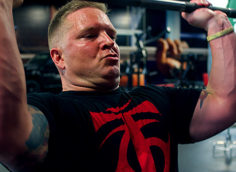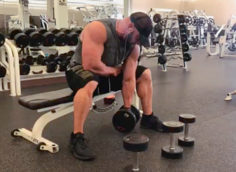To keep making progress in the gym, you must keep challenging your body. The problem is, many lifters only have two methods in their toolbox to do this: adding more weight to the bar or changing exercises. There's a time and place for both, but there are other tools available too, like the 40 Reps Method.
The 40 Reps Method
When most people think of sets and reps, their fallback scheme is 3 sets of 10 reps (3x10). Here's something different that will break you out of a training rut: forget about the number of sets. Instead, think about hitting a certain amount of total reps for the exercise. A good number to shoot for is 40 reps. So your goal is to accumulate 40 reps for a particular exercise. The number of sets is (almost) meaningless.
The secret is in choosing the weight you use on the exercise. Load the bar or machine with a weight you can lift for 8 reps – your 8 rep max. That's the load you'll use for the whole exercise.
Note: This is the point where many OCD lifters ask about percentage of 1RM. I don't think it's necessary to do that much math every workout. Look, it's easy. If you can get over 8 reps on the first set, it's too light. If you can't get 8 reps on the first set, it's too heavy. You'll figure it out.
With your load selected, you'll now shoot for 40 total reps for the exercise, regardless of how many sets it takes. You won't even try to count sets, only reps. As you fatigue, you won't be able to get the same number of reps per round, and that's fine because we're only concerned with total reps. Here's an example:
- Exercise: Biceps Curl
- Reps: 40 total
- Load: 8RM
- Sets: Doesn't matter
- Rest: 45 seconds between sets
- Set 1: 8 reps
- Set 2: 8 reps
- Set 3: 6 reps
- Set 4: 5 reps
- Set 5: 4 reps
- Set 6: 4 reps
- Set 7: 3 reps
- Set 8: 2 reps
- Total reps: 40
Compare that to 3x10. You've completed more reps using a heavier weight while at the same time increasing work capacity. Not bad.
Remember, you're only resting 45 seconds between sets and you're starting with your 8RM, so every set will be taken to failure. If you can get 8 reps on every set, then you either started too light and sandbagged the first few sets, or you rested way longer than 45 seconds between sets.
Also, remember that the above is just an example. You may be able to finish off all 40 reps in 6 or 7 sets. Or it could take you 10 sets where you're down to doing singles at the end. It all works as long as you're following the load and rest guidelines.
Set your rep goal for the exercise at 20. To choose your weight, load up the bar with your 4RM. Rest for only 30 seconds between sets. It might look like this:
- Set 1: 4 reps
- Set 2: 3 reps
- Set 3: 3 reps
- Set 4: 2 reps
- Set 5: 2 reps
- Set 6: 1 rep
- Set 7: 1 rep
- Set 8: 1 rep
- Set 9: 1 rep
- Set 10: 1 rep
- Set 11: 1 rep
- Total reps: 20
This method is the core workout of our Velocity Diet program. You can download the free ebook here which contains a full training program.
Chad Waterbury popularized this method here on T Nation. See the related links below for all the details as well as some other variations.





